Spatial Configuration and Layout Optimization of the Ecological Networks in a High-Population-Density Urban Agglomeration: A Case Study of the Central Plains Urban Agglomeration
Abstract
1. Introduction
2. Materials and Methods
2.1. Study Area
2.2. Methodology
2.2.1. Land Use Transfer Matrix
2.2.2. Assessing the ESV
2.2.3. Ecological Source Identification
2.2.4. Source Patch Significance Evaluation
2.2.5. Building Ecological Resistance Surfaces
2.2.6. Ecological Corridor Identification
2.3. Data Sources
3. Results
3.1. Spatio-Temporal Evolution in LUCC
3.1.1. Temporal Trend of LUCC
3.1.2. Spatial Distribution of LUCC
3.1.3. Changes in Land Use Transfers
3.2. Spatio-Temporal Evolution of ESV
3.2.1. Temporal Trend in ESV
3.2.2. Spatial Distribution of ESV
3.3. Ecological Network Construction
3.3.1. Landscape Pattern Analysis
3.3.2. Identification of Ecological Sources
3.3.3. Construction of the Comprehensive Ecological Resistance Surface
3.3.4. Construction of the Ecological Network in the CPUA
3.4. Optimized Spatial Layout of Ecological Spaces
3.4.1. Construction of Ecological Protection Belts
3.4.2. Delineation of Ecological Functional Zones
3.4.3. Optimizing Connectivity of Ecological Corridors
4. Discussion
4.1. Spatial Structure Evolution in LUCC and ESV
4.2. Value Assessment of Ecological Network Optimization
4.3. Limitations and Future Perspectives
5. Conclusions
- (1)
- The CPUA’s land use structure underwent significant changes. Cultivated land area steadily decreased, bare land followed a pattern of “increase, then decrease”, and construction land expanded rapidly. Meanwhile, forest and grassland areas remained stable, reflecting the effectiveness of ecological protection policies. Regarding land transfer, cultivated land transitioned to construction land, with a transfer area totaling 15,860.59 km2, making up 77.14% of all transferred land. Forest and waterbody transfers were roughly balanced, with a gradual increase over time. Grassland and bare land were mostly transferred to cultivated or construction land, resulting in an overall reduction in their area. These frequent transfers between land types reveal the dynamic balance between urban growth and ecological protection needs.
- (2)
- From 2005 to 2020, the ESV of the CPUA decreased by 1.27 billion dollars, exhibiting clear spatial differentiation. Areas with high ESVs are mainly found in the hilly regions of Nanyang, Xinyang, Pingdingshan, and Zhumadian in the southwest, where high levels of ecological services are maintained due to water conservation and soil retention functions. Medium-ESV areas are concentrated in Sanmenxia, Yuncheng, and Jincheng in the west, characterized by diverse land use types and relatively stable ecological functions. Low-ESV areas, which make up the largest portion, are mainly composed of construction and cultivated land, spread widely across the central and western regions of the CPUA. These areas exhibit weaker ecological service functions due to disturbances from urbanization and agricultural production. The changes in ESVs across different land types highlight the challenges of maintaining ecosystem balance amid rapid urbanization and land use restructuring in the CPUA.
- (3)
- Utilizing the natural features of the CPUA, this study constructed an ecological network comprising 20 ecological sources and 36 corridors. Ecological sources are approximately 21,434.70 km2, primarily located in the western region, extending across the Taihang, Dabie, and Funiu mountain ranges. The ecological corridors span approximately 2795.19 km, running predominantly in a north–south direction through the central and western regions of the agglomeration, involving major cities like Zhengzhou and Luoyang. By integrating spatial variations in LUCCs and ESVs, this study proposes an optimized ecological spatial layout of “five belts, six zones, multiple clusters, and corridors” and develops differentiated strategies to address regional ecological issues. These strategies aim to harmonize ecological protection and restoration efforts while promoting sustainable ecological and economic development across the CPUA.
Author Contributions
Funding
Data Availability Statement
Conflicts of Interest
References
- Turok, I.; McGranahan, G. Urbanization and economic growth: The arguments and evidence for Africa and Asia. Environ. Urban. 2013, 25, 465–482. [Google Scholar] [CrossRef]
- Wang, C.; Wang, Q.; Liu, N.; Sun, Y.; Guo, H.; Song, X. The impact of LUCC on the spatial pattern of ecological network during urbanization: A case study of Jinan City. Ecol. Indic. 2023, 155, 111004. [Google Scholar] [CrossRef]
- Li, C.; Fang, S.; Geng, X.; Yuan, Y.; Zheng, X.; Zhang, D.; Li, R.; Sun, W.; Wang, X. Coastal ecosystem service in response to past and future land use and land cover change dynamics in the Yangtze river estuary. J. Clean. Prod. 2023, 385, 135601. [Google Scholar] [CrossRef]
- Ondik, M.M.; Ooi, M.K.J.; Muñoz-Rojas, M. Soil microbial community composition and functions are disrupted by fire and land use in a Mediterranean woodland. Sci. Total Environ. 2023, 895, 165088. [Google Scholar] [CrossRef]
- Xiong, X.; Zhou, T.; Cai, T.; Huang, W.; Li, J.; Cui, X.; Li, F. Land Use Transition and Effects on Ecosystem Services in Water-Rich Cities under Rapid Urbanization: A Case Study of Wuhan City, China. Land 2022, 11, 1153. [Google Scholar] [CrossRef]
- Tian, Y.; Jim, C.Y.; Tao, Y.; Shi, T. Landscape ecological assessment of green space fragmentation in Hong Kong. Urban For. Urban Green. 2011, 10, 79–86. [Google Scholar] [CrossRef]
- Sutton, P.C.; Anderson, S.J.; Costanza, R.; Kubiszewski, I. The ecological economics of land degradation: Impacts on ecosystem service values. Ecol. Econ. 2016, 129, 182–192. [Google Scholar] [CrossRef]
- Han, B.; Liu, H.; Wang, R. Urban ecological security assessment for cities in the Beijing-Tianjin-Hebei metropolitan region based on fuzzy and entropy methods. Ecol. Model. 2015, 318, 217–225. [Google Scholar] [CrossRef]
- Levis, C.; Flores, B.M.; Campos-Silva, J.V.; Peroni, N.; Staal, A.; Padgurschi, M.G.; Dorshow, W.; Moraes, B.; Schmidt, M.; Kuikuro, T.W.; et al. Contributions of human cultures to biodiversity and ecosystem conservation. Nat. Ecol. Evol. 2024, 8, 866–879. [Google Scholar] [CrossRef]
- Zhang, C.; Su, B.; Beckmann, M.; Volk, M. Emergy-based evaluation of ecosystem services: Progress and perspectives. Renew. Sustain. Energy Rev. 2024, 192, 114201. [Google Scholar] [CrossRef]
- Zhou, J.; Hou, Q.; Li, W. Spatial resilience assessment and optimization of small watershed based on complex network theory. Ecol. Indic. 2022, 145, 109730. [Google Scholar] [CrossRef]
- Yu, T.; Jia, S.; Zhang, Y.; Cui, X. How can urban expansion and ecological preservation be balanced? A simulation of the spatial dynamics of production-living-ecological spaces in the Huaihe River Eco-Economic Belt. Ecol. Indic. 2025, 171, 113192. [Google Scholar] [CrossRef]
- Yang, J.; Deng, W.; Zhang, G.; Cui, X. Linking endangered species protection to construct and optimize ecological security patterns in the National ecological Civilization construction Demonstration Zone: A case study of Yichang, China. Ecol. Indic. 2024, 158, 111579. [Google Scholar] [CrossRef]
- Wang, X.; Wang, C.; Shi, J. Spatial and temporal evolution of urban resilience and its transition mechanism in Zhongyuan Urban Agglomeration. Sci. Geogr. Sin. 2024, 7, 44. [Google Scholar] [CrossRef]
- Chen, Y.; Zhou, P.; Zhang, H. Analysis on Driving Forces and Evolution Process of Logistics in the Central Plains Urban Agglomeration. Int. J. Soc. Sci. Innov. Educ. Technol. 2021, 15, 56. [Google Scholar]
- Mu, W.; Zhu, X.; Ma, W.; Han, Y.; Huang, H.; Huang, X. Impact assessment of urbanization on vegetation net primary productivity: A case study of the core development area in central plains urban agglomeration, China. Environ. Res. 2023, 229, 115995. [Google Scholar] [CrossRef]
- Troll, C. Landschaftsökologie und Biogeographie. Stuttg. Geogr. Stud. 1939, 7, 179–188. [Google Scholar]
- Forman, R.T.T.; Godron, M. Landscape Ecology; John Wiley & Sons: New York, NY, USA, 1986; Volume 4, pp. 22–28. [Google Scholar]
- Qu, Y.; Lu, M. Research progress on development trend of ecological network planning. Urban Dev. Stud. 2016, 23, 29–36. [Google Scholar]
- Chauhan, S.; Yadav, G.; Babu, S. Ecological networks in urban forest fragments reveal species associations between native and invasive plant communities. Plants 2022, 11, 541. [Google Scholar] [CrossRef]
- Zhou, G.J.; Huan, Y.Z.; Wang, L.Q.; Zhang, R.Q.; Liang, T.; Han, X.X.; Feng, Z.H. Constructing a multi-leveled ecological security pattern for improving ecosystem connectivity in the Asian water Tower region. Ecol. Indic. 2023, 154, 110597. [Google Scholar] [CrossRef]
- Li, M.; Zhou, Q.; Meng, H.; Peng, C.; Liu, X.; Zhou, L. Ecological Security Layout Planning of Chongqing Section in the Three Gorges Reservoir Area Based on the Model of Minimum Cumulative Coefficient. Resour. Environ. Yangtze Basin 2021, 30, 1916–1926. [Google Scholar] [CrossRef]
- Fan, S.X.; Axmacher, J.C.; Shu, H.J.; Liu, Y.H. Ecological network design based on optimizing ecosystem services: Case study in the Huang-Huai-Hai region, China. Ecol. Indic. 2023, 150, 110264. [Google Scholar] [CrossRef]
- Yang, Q.; Wang, L.; Li, Y.; Qin, X. Urban spatial expansion mode based on the construction of landscape ecological security pattern: A case of the coastal area of Jiangsu. Sci. Geogr. Sin. 2021, 41, 737–746. [Google Scholar] [CrossRef]
- Zhang, S.; Xiong, K.; Qin, Y.; Min, X.; Xiao, J. Evolution and determinants of ecosystem services: Insights from South China karst. Ecol. Indic. 2021, 133, 108437. [Google Scholar] [CrossRef]
- Ye, X.; Zou, C.X.; Liu, G.H.; Lin, N.; Xu, M. Main research contents and advances in the ecological security pattern. Acta Ecol. Sin. 2018, 38, 3382–3392. [Google Scholar]
- Zhao, X.Q.; Xu, X.H. Research on landscape ecological security pattern in a eucalyptus introduced region based on biodiversity conservation. Russ. J. Ecol. 2015, 46, 59–70. [Google Scholar] [CrossRef]
- Aminzadeh, B.; Khansefid, M. A case study of urban ecological networks and a sustainable city: Tehran’s metropolitan area. Urban Ecosyst. 2010, 13, 23–36. [Google Scholar] [CrossRef]
- Liu, X.Y.; Wei, M.; Zeng, J.; Zhang, S. Ecological network analysis and construction: A case study of the urban agglomeration of the Min River Delta, China. Resour. Sci. 2021, 43, 357–367. [Google Scholar] [CrossRef]
- Wei, Q.Q.; Halike, A.; Yao, K.X.; Chen, L.; Balati, M. Construction and optimization of ecological security pattern in Ebinur Lake Basin based on MSPA-MCR models. Ecol. Indic. 2022, 138, 108857. [Google Scholar] [CrossRef]
- Wang, C.; Yu, C.; Chen, T.; Feng, Z.; Hu, Y.; Wu, K. Can the establishment of ecological security patterns improve ecological protection? An example of Nanchang, China. Sci. Total Environ. 2020, 740, 140051. [Google Scholar] [CrossRef] [PubMed]
- Wang, Y.; Pan, J. Building ecological security patterns based on ecosystem services value reconstruction in an arid inland basin: A case study in Ganzhou District, NW China. J. Clean. Prod. 2019, 241, 118337. [Google Scholar] [CrossRef]
- Ye, Y.; Su, Y.; Zhang, H.; Liu, K.; Wu, Q. Construction of an ecological resistance surface model and its application in urban expansion simulations. J. Geogr. Sci. 2015, 25, 211–224. [Google Scholar] [CrossRef]
- Wang, G.; Li, J.; Liu, X.; Li, B.; Zhang, Y. Social-ecological network of peri-urban forest in urban expansion: A case study of urban agglomeration in Guanzhong Plain, China. Land Use Policy 2024, 139, 107074. [Google Scholar] [CrossRef]
- Zhou, G.; Huan, Y.; Wang, L.; Lan, Y.; Liang, T.; Shi, B.; Zhang, Q. Linking ecosystem services and circuit theory to identify priority conservation and restoration areas from an ecological network perspective. Sci. Total Environ. 2023, 873, 162261. [Google Scholar] [CrossRef]
- Yang, T.R.; Kuang, W.H.; Liu, W.D.; Liu, A.L.; Pan, T. Optimizing the layout of eco-spatial structure in Guanzhong urban agglomeration based on the ecological security pattern. Geogr. Res. 2017, 36, 441–452. [Google Scholar] [CrossRef]
- Fath, B.D.; Asmus, H.; Asmus, R.; Baird, D.; Borrett, S.R.; de Jonge, V.N.; Ludovisi, A.; Niquil, N.; Scharler, U.M.; Schückel, U.; et al. Ecological network analysis metrics: The need for an entire ecosystem approach in management and policy. Ocean Coast. Manag 2019, 174, 1–14. [Google Scholar] [CrossRef]
- Huang, X.X.; Wang, H.J.; Shan, L.Y.; Xiao, F. Constructing and optimizing urban ecological network in the context of rapid urbanization for improving landscape connectivity. Ecol. Indic. 2021, 132, 108319. [Google Scholar] [CrossRef]
- Xu, D.; Peng, J.; Jiang, H.; Dong, J.; Liu, M.; Chen, Y.; Wu, J.; Meermans, J. Incorporating barriers restoration and stepping stones establishment to enhance the connectivity of watershed ecological security patterns. Appl. Geogr. 2024, 170, 103347. [Google Scholar] [CrossRef]
- Chen, W.; Gu, T.; Xiang, J.; Luo, T.; Zeng, J.; Yuan, Y. Ecological restoration zoning of territorial space in China: An ecosystem health perspective. J. Environ. Manag. 2024, 364, 121371. [Google Scholar] [CrossRef]
- Wang, H.Y.; Niu, W.H.; Song, M.; Zhang, B.B.; Jin, Y.Y. Construction and spatial optimization of ecological network in Shaanxi Province based on LUCC and its ESV response. Resour. Sci. 2023, 45, 1380–1395. [Google Scholar] [CrossRef]
- Wang, Y.; Qu, Z.; Zhong, Q.; Zhang, Q.; Zhang, L.; Zhang, R.; Yi, Y.; Zhang, G.; Li, X.; Liu, J. Delimitation of ecological corridors in a highly urbanizing region based on circuit theory and MSPA. Ecol. Indic. 2022, 142, 109258. [Google Scholar] [CrossRef]
- Li, Y.; Liu, W.; Feng, Q.; Zhu, M.; Yang, L.; Zhang, J.; Yin, X. The role of land use change in affecting ecosystem services and the ecological security pattern of the Hexi Regions, Northwest China. Sci. Total Environ. 2023, 855, 158940. [Google Scholar] [CrossRef] [PubMed]
- Mu, H.; Li, X.; Ma, H.; Du, X.; Huang, J.; Su, W.; Yu, Z.; Xu, C.; Liu, H.; Yin, D.; et al. Evaluation of the policy-driven ecological network in the Three-North Shelterbelt region of China. Landsc. Urban Plan. 2022, 218, 104305. [Google Scholar] [CrossRef]
- Luo, G.; Jin, T.; Zhang, H.; Peng, J.; Zuo, N.; Huang, Y.; Han, Y.; Tian, C.; Yang, Y.; Peng, K.; et al. Deciphering the diversity and functions of plastisphere bacterial communities in plastic-mulching croplands of subtropical China. J. Hazard. Mater. 2022, 422, 126865. [Google Scholar] [CrossRef]
- Yang, J.; Zeng, C.; Cheng, Y. Spatial influence of ecological networks on land use intensity. Sci. Total Environ. 2020, 717, 137151. [Google Scholar] [CrossRef]
- Fang, C.L. Progress and the future direction of research into urban agglomeration in China. Acta Geogr. Sin. 2014, 69, 1130–1144. [Google Scholar] [CrossRef]
- Li, S.C.; Gong, J.; Yang, J.X.; Zhang, Z.; Zhang, M. Characteristics of LUCC patterns of the Lanzhou-Xining urban agglomeration: Based on an intensity analysis framework. Resour. Sci. 2023, 45, 480–493. [Google Scholar] [CrossRef]
- Liu, Y.; Yuan, X.; Li, J.; Qian, K.; Yan, W.; Yang, X.; Ma, X. Trade-offs and synergistic relationships of ecosystem services under land use change in Xinjiang from 1990 to 2020: A Bayesian network analysis. Sci. Total Environ. 2023, 858, 160015. [Google Scholar] [CrossRef]
- Zhang, P.; Liu, L.; Yang, L.; Zhao, J.; Li, Y.; Qi, Y.; Ma, X.; Cao, L. Exploring the response of ecosystem service value to land use changes under multiple scenarios coupling a mixed-cell cellular automata model and system dynamics model in Xi’an, China. Ecol. Indic. 2023, 147, 110009. [Google Scholar] [CrossRef]
- Costanza, R.; d’Arge, R.; de Groot, R.; Farber, S.; Grasso, M.; Hannon, B.; Limburg, K.; Naeem, S.; O’Neill, R.; Paruelo, J.; et al. The value of the world’s ecosystem services and natural capital. Nature 1997, 387, 253–260. [Google Scholar] [CrossRef]
- Xie, G.D.; Zhang, C.X.; Zhang, L.M.; Chen, W.H.; Li, S.M. Improvement of the evaluation method for ecosystem service value based on per unit area. J. Nat. Resour. 2015, 30, 1243–1254. [Google Scholar] [CrossRef]
- Zhao, Y.; Zhang, X.; Wu, Q.; Huang, J.; Ling, F.; Wang, L. Characteristics of spatial and temporal changes in ecosystem service value and threshold effect in Henan along the Yellow River, China. Ecol. Indic. 2024, 166, 112531. [Google Scholar] [CrossRef]
- Wang, W.; Sun, T.; Wang, J.; Fu, Q.; An, C. Annual Dynamic Monitoring of Regional Ecosystem Service Value Based on Multi-source Remote Sensing Data: A Case of Central Plains Urban Agglomeration Region. Sci. Geogr. Sin. 2019, 39, 680–687. [Google Scholar] [CrossRef]
- Li, J.; Hu, D.; Wang, Y.; Chu, J.; Yin, H.; Ma, M. Study of identification and simulation of ecological zoning through integration of landscape ecological risk and ecosystem service value. Sustain. Cities Soc. 2024, 107, 105442. [Google Scholar] [CrossRef]
- Huang, L.; Chen, Z.; Yang, Z.; Chen, M.; Chen, X.; Zhai, T.; Qiu, T. Integrating “quality-risk-demand” framework and circuit theory to identify spatial range and priority area of ecological security pattern in a rapidly urbanizing landscape. Ecol. Inform. 2024, 82, 102673. [Google Scholar] [CrossRef]
- Gu, T.; Tong, Y.; Wang, S.; You, Z.; Li, D.; Jiang, Y.; Rafaqat, A.; Wang, C.; Zhang, Q. Identifying the priority areas for ecological protection considering ecological connectivity and ecosystem integrity: A case study of Xianyang City, China. Ecol. Indic. 2024, 163, 112102. [Google Scholar] [CrossRef]
- Huang, J.; Guang, P.; Gao, J.; Wang, X.; Guo, H. Multiscale spatiotemporal characteristics and influencing factors of ecosystem service value of groundwater in China. J. Environ. Manag. 2024, 368, 122196. [Google Scholar] [CrossRef]
- Tiang, D.C.F.; Morris, A.; Bell, M.; Gibbins, C.N.; Azhar, B.; Lechner, A.M. Ecological connectivity in fragmented agricultural landscapes and the importance of scattered trees and small patches. Ecol. Process. 2021, 10, 20. Available online: https://link.springer.com/article/10.1186/S13717-021-00284-7 (accessed on 30 March 2025).
- Han, Y.; Wang, J.; Yu, S.; Cheng, S.; Li, Y. Construction and optimization of ecological network in the Saihanba area. J. Arid Land Resour. Environ. 2023, 37, 112–121. [Google Scholar] [CrossRef]
- Cao, W.; Jia, G.; Yang, Q.; Sun, H.; Wang, L.; Svenning, J.C.; Wen, L. Construction of ecological network and its temporal and spatial evolution characteristics: A case study of Ulanqab. Ecol. Indic. 2024, 166, 112344. [Google Scholar] [CrossRef]
- Qian, M.; Huang, Y.; Cao, Y.; Wu, J.; Xiong, Y. Ecological network construction and optimization in Guangzhou from the perspective of biodiversity conservation. J. Environ. Manag. 2023, 336, 117692. [Google Scholar] [CrossRef]
- Liang, J.; He, X.; Zeng, G.; Zhou, M.; Guo, X.; Li, X.; Li, X.; Wu, H.; Feng, C.; Xing, W.; et al. Integrating priority areas and ecological corridors into national network for conservation planning in China. Sci. Total Environ. 2018, 626, 22–29. [Google Scholar] [CrossRef] [PubMed]
- Brend’Amour, C.; Reitsma, F.; Baiocchi, G.; Seto, K. Future urban land expansion and implications for global croplands. Proc. Natl. Acad. Sci. USA 2017, 114, 8939–8944. [Google Scholar] [CrossRef] [PubMed]
- Lei, X.; Hai, X. Assessing economic value of carbon storage and land use changes based on the coupled PLUS-InVEST model in Lanzhou City. Sci. Geogr. Sin. 2025, 2, 45. [Google Scholar] [CrossRef]
- Zhang, X.L.; Niu, C.H.; Ma, S.; Wang, L.J.; Hu, H.B.; Jiang, J. Exploring ecological compensation standards in the urbanization process: An ecosystem service value-based perspective. Ecol. Indic. 2024, 166, 112510. [Google Scholar] [CrossRef]
- Yang, H.; Gou, X.; Xue, B.; Ma, W.; Kuang, W.; Tu, Z.; Gao, L.; Yin, D.; Zhang, J. Research on the change of alpine ecosystem service value and its sustainable development path. Ecol. Indic. 2023, 146, 109893. [Google Scholar] [CrossRef]
- Feng, Z.; Sun, L. Response of spatial and temporal variations of ecosystem service value to land use/land cover transformation in the upper basin of Miyun Reservoir. Ecol. Indic. 2024, 160, 111819. [Google Scholar] [CrossRef]
- Jiang, H.; Peng, J.; Xu, D.; Tang, H. Constructing ecological security patterns with differentiated management intensity based on multifunctional landscape identification and multi-criteria decision-making. Glob. Ecol. Conserv. 2024, 50, e02862. [Google Scholar] [CrossRef]
- Liang, K.; Jin, X.; Zhang, X.; Song, P.; Li, Q.; Yong, S.; Qi, K.; Zhou, Y. Construction of ecological security patterns coupling supply and demand of ecosystem services: A case study of Southern Jiangsu Province. Acta Ecol. Sin. 2024, 44, 3880–3896. [Google Scholar] [CrossRef]
- Zhang, Z.; Wang, Q.; Feng, Y.; Sun, Y.; Liu, N.; Yan, S. The spatio-temporal evolution of spatial structure and supply-demand relationships of the ecological network in the Yellow River Delta region of China. J. Clean. Prod. 2024, 471, 143388. [Google Scholar] [CrossRef]
- Tian, H.; Wang, H.; Lyu, X.; Li, X.; Yang, Y.; Zhang, Y.; Liu, J.; Lu, Y.; Zhao, X.; Qu, T.; et al. Construction and optimization of ecological security patterns in Dryland watersheds considering ecosystem services flows. Ecol. Indic. 2024, 159, 111664. [Google Scholar] [CrossRef]
- Wang, T.; Huang, Y.; Cheng, J.; Xiong, H.; Ying, Y.; Feng, Y.; Wang, J. Construction and optimization of watershed-scale ecological network based on complex network method: A case study of Erhai Lake Basin in China. Ecol. Indic. 2024, 160, 111794. [Google Scholar] [CrossRef]
- Shuai, N.; Hu, Y.; Chen, J.; Liu, X.; Bai, Y. Does ecological network affect the construction land spatial development intensity? An empirical study based on the main urban area of Jinan, China. Ecol. Inform. 2024, 81, 102609. [Google Scholar] [CrossRef]
- Liu, M.; Peng, J.; Dong, J.; Jiang, H.; Xu, D.; Meersmans, J. Trade-offs of landscape connectivity between regional and interregional ecological security patterns in a junction area of the Beijing-Tianjin-Hebei region. Appl. Geogr. 2024, 167, 103272. [Google Scholar] [CrossRef]
- Li, Q.; Zhou, Y.; Yi, S. An integrated approach to constructing ecological security patterns and identifying ecological restoration and protection areas: A case study of Jingmen, China. Ecol. Indic. 2022, 137, 108723. [Google Scholar] [CrossRef]
- Xiang, K.; Chen, L.; Li, W.; He, Z. Construction and Optimization Strategy of Ecological Security Pattern in County-Level Cities under Spatial and Temporal Variation of Ecosystem Services: Case Study of Mianzhu, China. Land 2024, 13, 936. [Google Scholar] [CrossRef]
- Nie, W.; Shi, Y.; Siaw, M.J.; Yang, F.; Wu, R.; Wu, X.; Zheng, X.; Bao, Z. Constructing and optimizing ecological network at county and town Scale: The case of Anji County, China. Ecol. Indic. 2021, 132, 108294. [Google Scholar] [CrossRef]
- Wang, J.; Bai, Y.; Huang, Z.; Ashraf, A.; Ali, M.; Fang, Z.; Lu, X. Identifying ecological security patterns to prioritize conservation and restoration: A case study in Xishuangbanna tropical region, China. J. Clean. Prod. 2024, 444, 141222. [Google Scholar] [CrossRef]
- Cui, L.; Wang, J.; Sun, L.; Lv, C. Construction and optimization of green space ecological networks in urban fringe areas: A case study with the urban fringe area of Tongzhou district in Beijing. J. Clean. Prod. 2020, 276, 124266. [Google Scholar] [CrossRef]
- Lin, Y.; An, W.; Gan, M.; Shahtahmassebi, A.R.; Ye, Z.; Huang, L.; Zhu, C.; Huang, L.; Zhang, J.; Wang, K. Spatial grain effects of urban green space cover maps on assessing habitat fragmentation and connectivity. Land 2021, 10, 1065. [Google Scholar] [CrossRef]
- Shen, W.; Liu, Q.; Ji, M.; He, J.; He, T.; Huang, X. Impacts of urban forests and landscape characteristics on land surface temperature in two urban agglomeration areas of China. Sustain. Cities Soc. 2023, 99, 104909. [Google Scholar] [CrossRef]
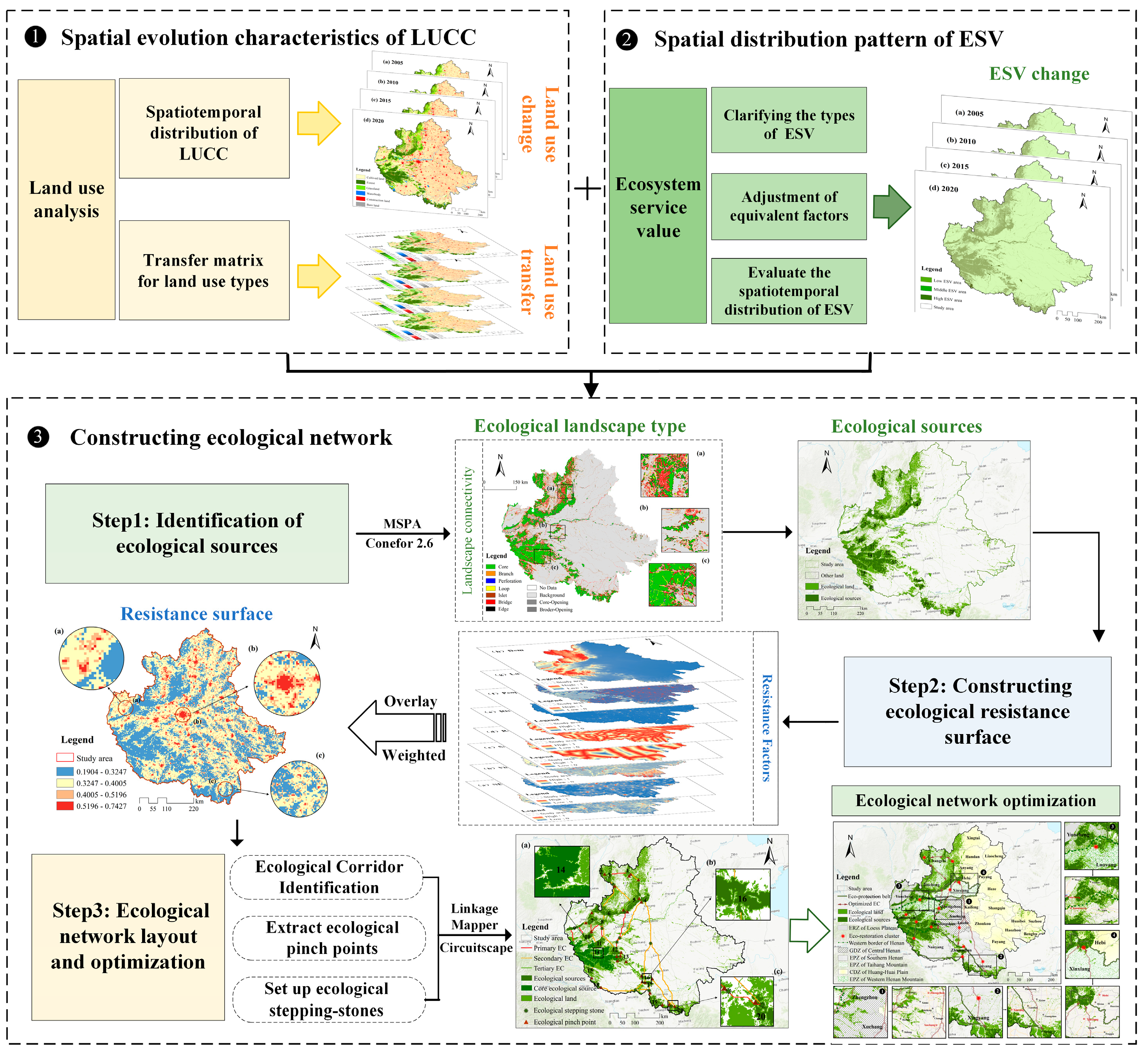

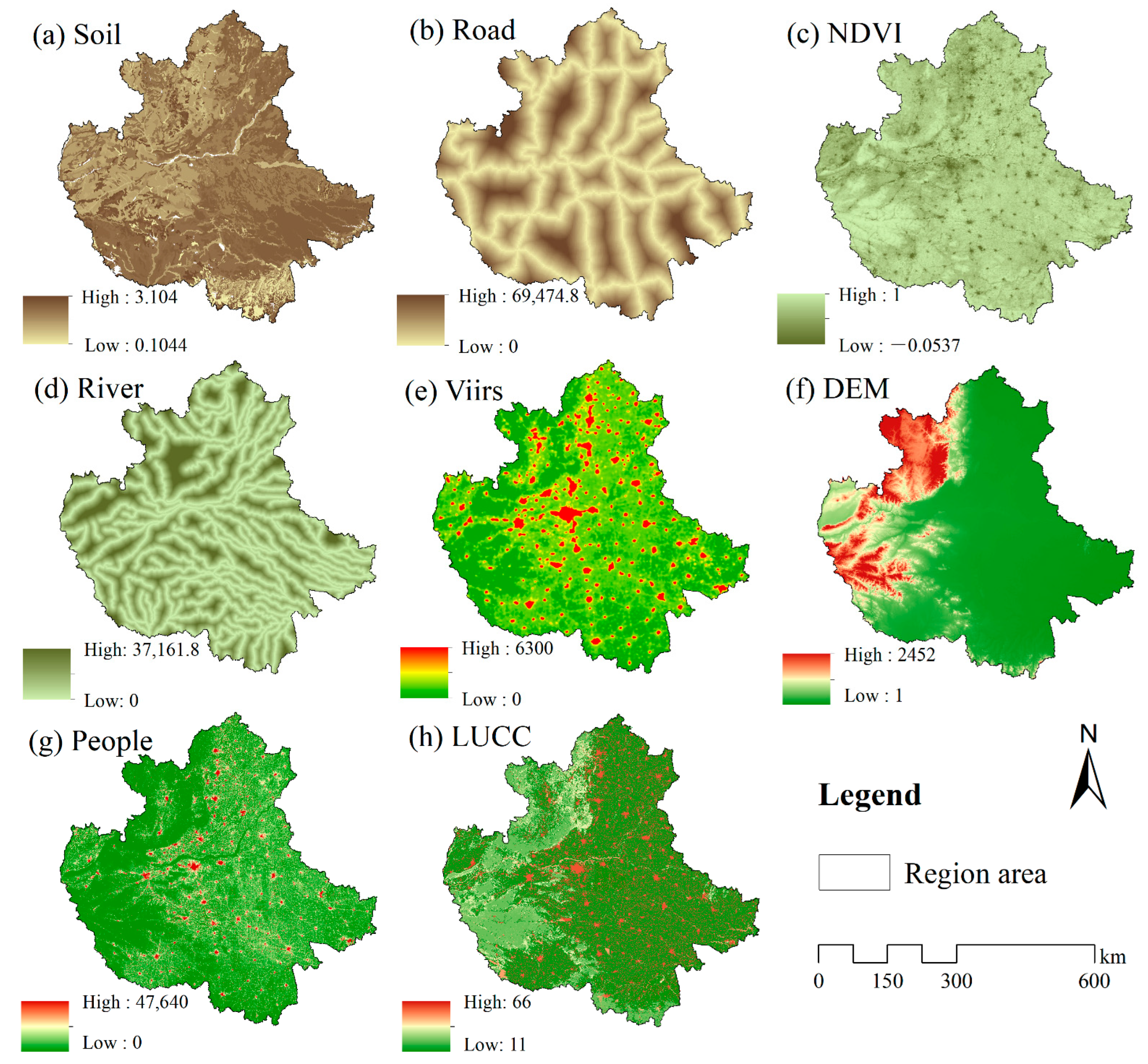
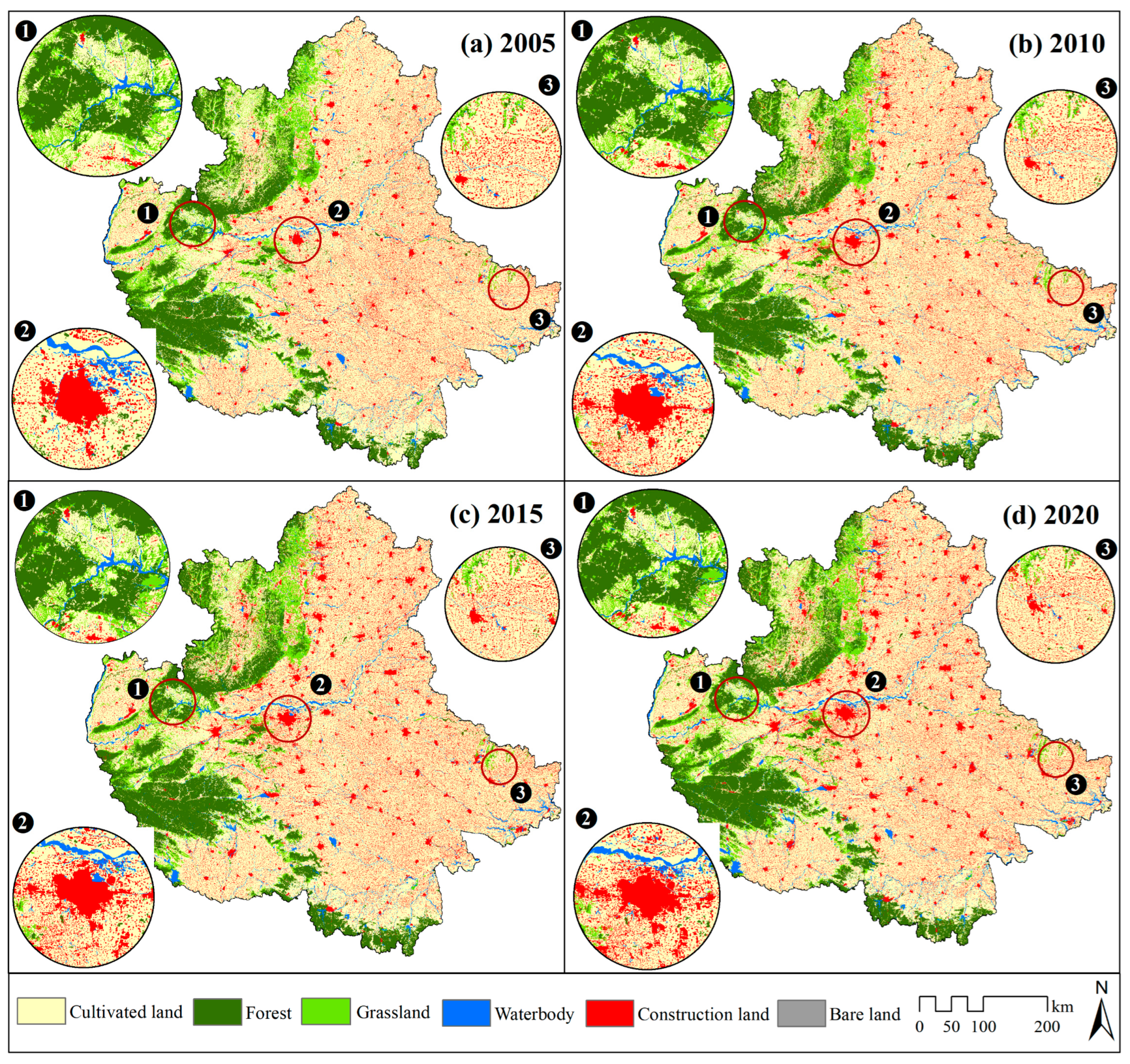

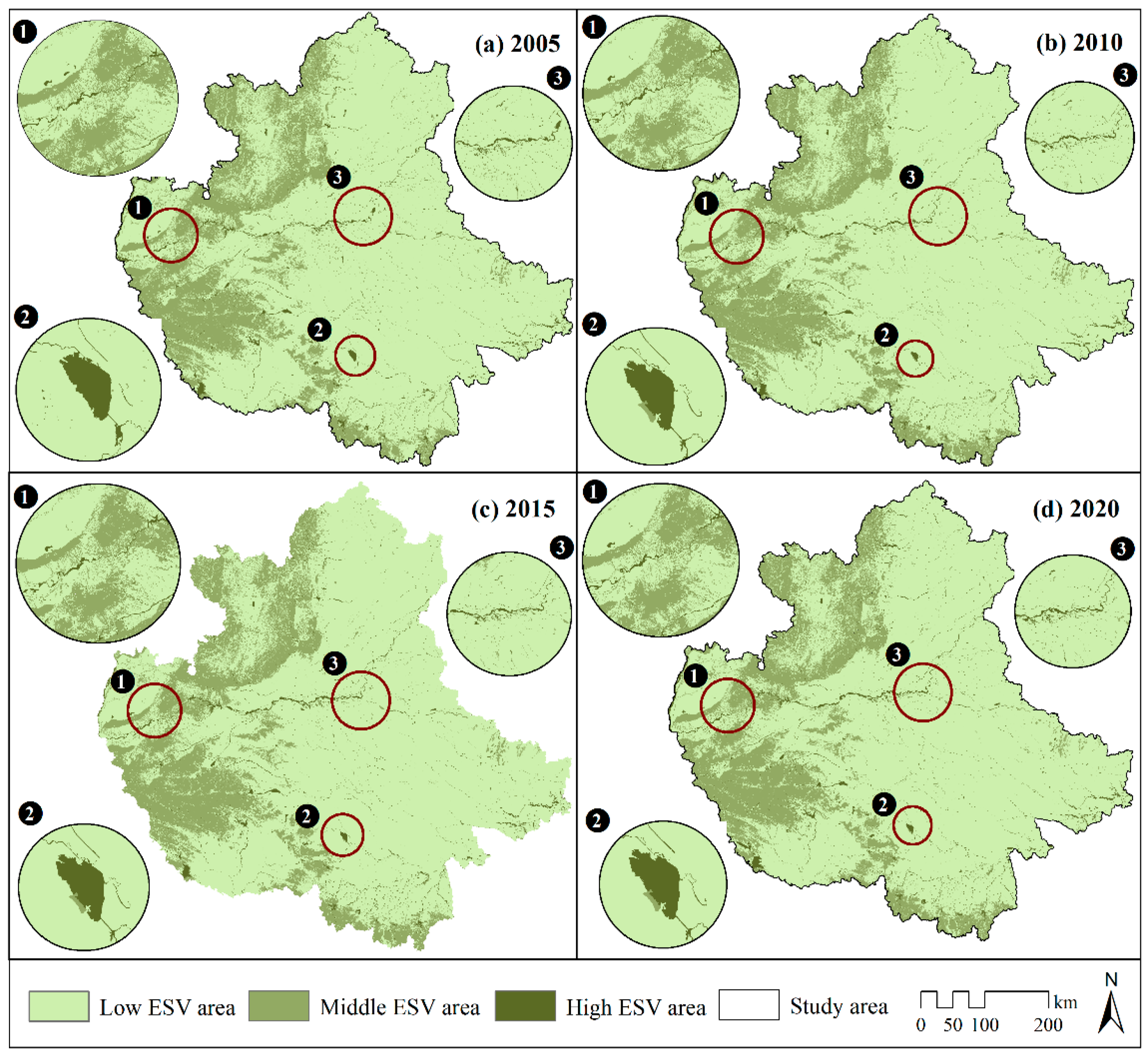

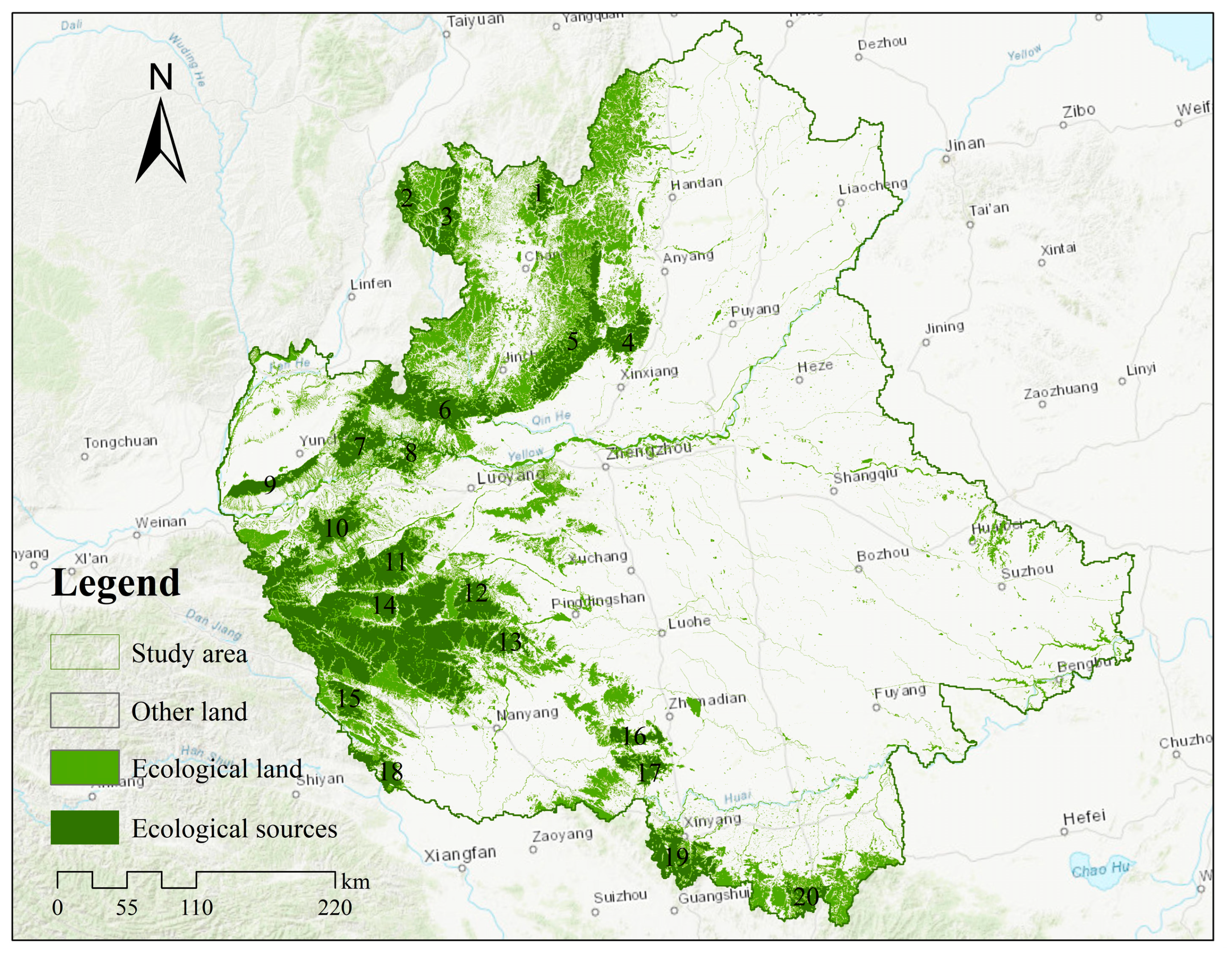
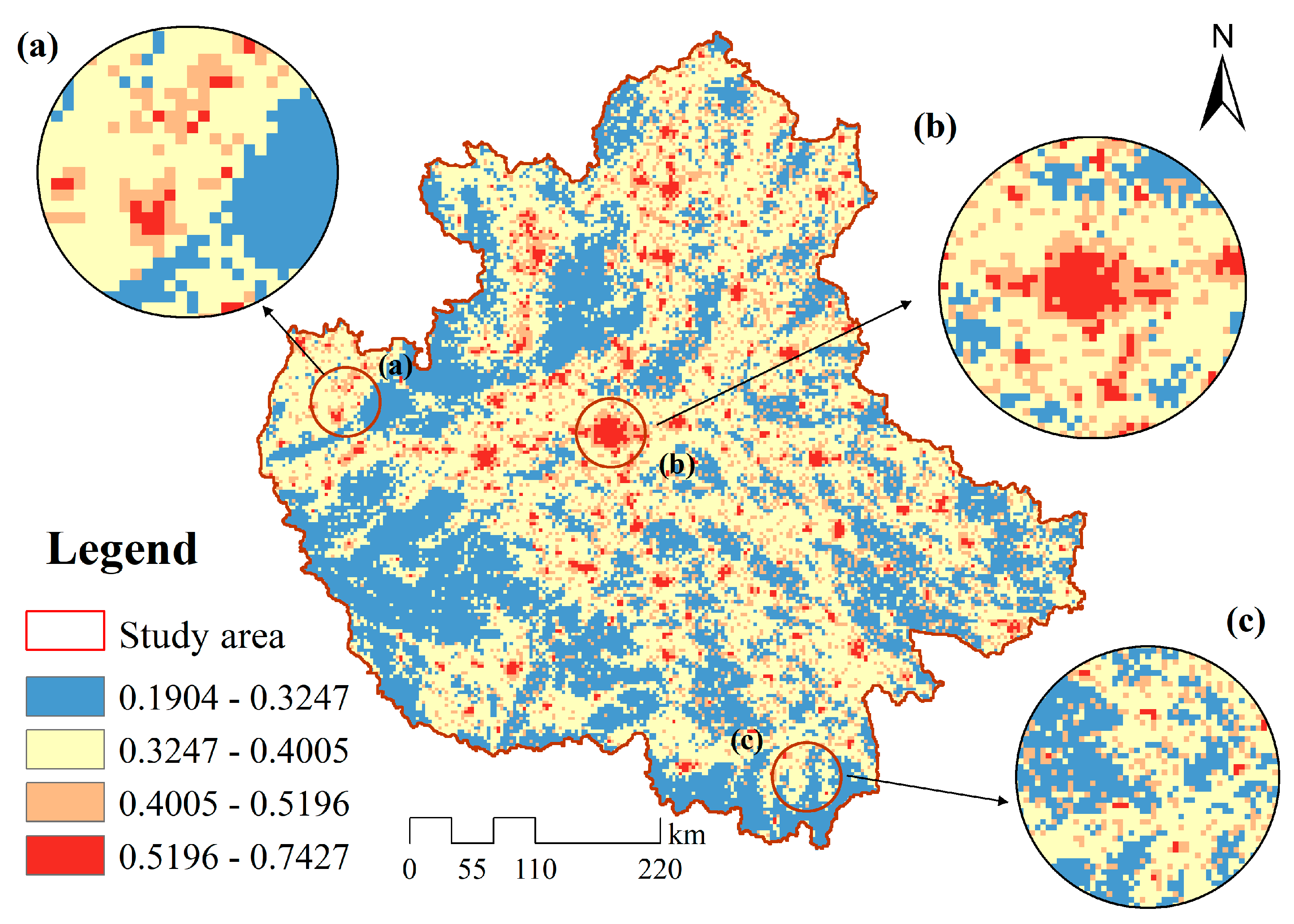

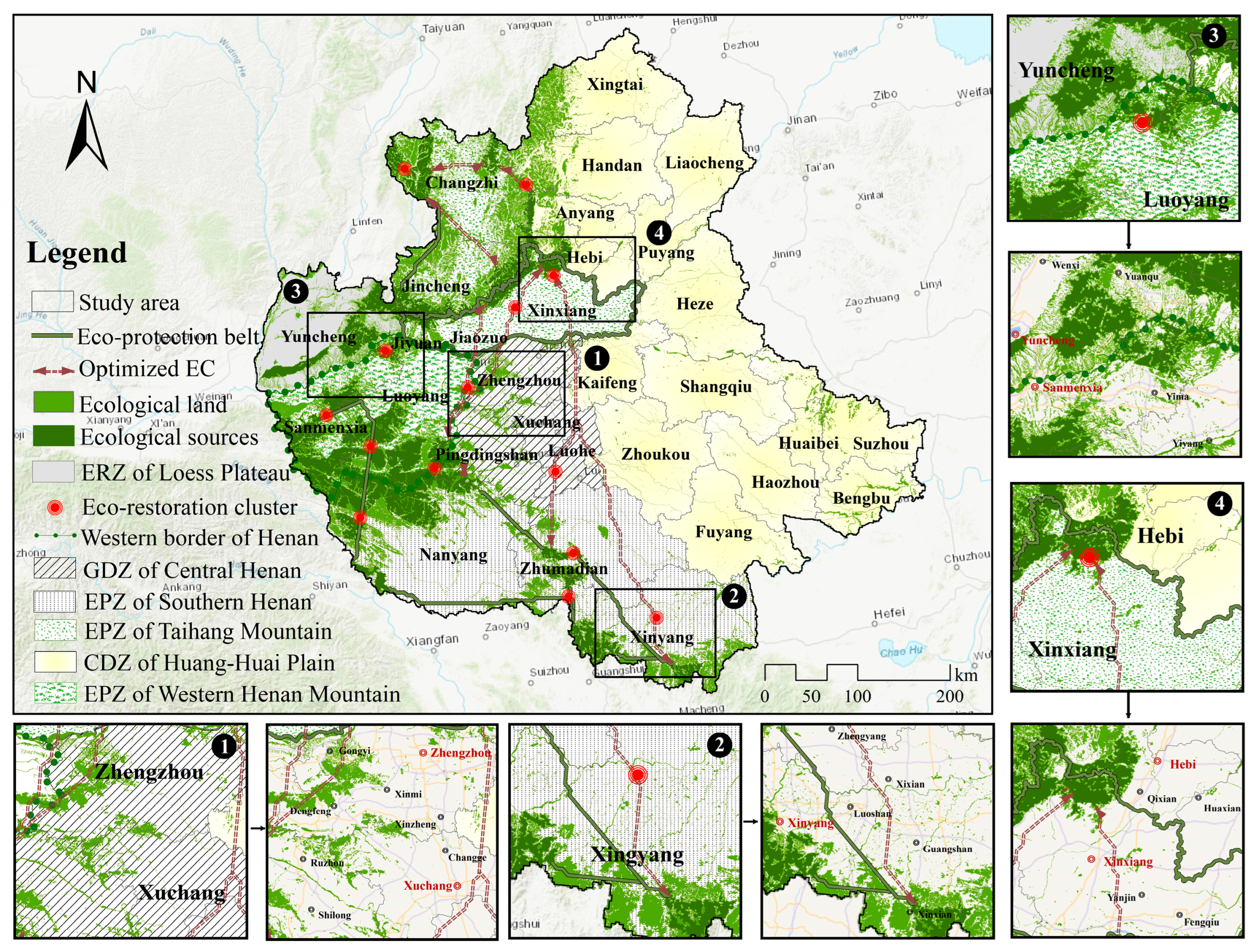
| Primary Classification | Secondary Classification | Cultivated Land | Forest | Grassland | Waterbody | Construction Land | Bare Land |
|---|---|---|---|---|---|---|---|
| Provisioning services | Food production | 366.28 | 82.65 | 100.77 | 241.15 | 0 | 6.74 |
| Raw materials | 81.21 | 188.72 | 148.50 | 98.61 | 0 | 8.84 | |
| Water supply | −432.58 | 97.90 | 82.21 | 2275.58 | 0 | 30.83 | |
| Regulating services | Gas regulation | 295.01 | 623.17 | 522.40 | 348.88 | 0 | 36.46 |
| Climate regulation | 154.14 | 1865.54 | 1381.59 | 867.64 | 0 | 50.83 | |
| Environment purification | 44.75 | 537.21 | 456.11 | 1678.09 | 0 | 90.60 | |
| Water regulation | 495.56 | 1068.23 | 1012.99 | 27425.40 | 0 | 295.90 | |
| Supporting services | Soil conservation | 172.37 | 758.86 | 636.43 | 422.63 | 0 | 43.20 |
| Nutrient cycling | 51.38 | 58.12 | 47.73 | 32.32 | 0 | 3.09 | |
| Nutrient cycling | 56.35 | 690.57 | 578.09 | 1286.12 | 0 | 103.53 | |
| Cultural services | Landscape esthetics | 24.86 | 302.97 | 254.57 | 861.83 | 0 | 59.44 |
| Types | Characteristic |
|---|---|
| Core | Core in green vegetation cover areas |
| Islet | Relatively isolated and small green patches |
| Perforation | Internal patch edge areas with no ecological benefit |
| Edge | Outer edges of core areas |
| Loop | Narrow areas with corridor characteristics connecting the same core area |
| Bridge | Corridor-like areas in non-core zones that connect various distinct core sites |
| Branch | Ecological patches linked to only one section of the core site |
| Type | Name | Weight | Sources | |
|---|---|---|---|---|
| Resistance factor | Natural factors | LUCC | 0.15 | Resource and Environment Science Data Platform (http://www.resdc.cn/ accessed on 11 September 2024) |
| DEM (m) | 0.09 | Geospatial Data Cloud (https://www.gscloud.cn/ accessed on 11 September 2024) | ||
| NDVI | 0.20 | EARTHDATA SEARCH (https://search.earthdata.nasa.gov/search accessed on 11 September 2024) | ||
| Soil total potassium content (g/kg) | 0.12 | Soil Science Database (http://vdb3.soil.csdb.cn/ accessed on 12 September 2024) | ||
| Socio-economic factors | Population density (persons/km2) | 0.16 | LandScan Global (https://landscan.ornl.gov accessed on 13 September 2024) | |
| Viirs | 0.13 | National Tibetan Plateau Data Center (https://data.tpdc.ac.cn/ accessed on 12 September 2024) | ||
| Distance to river (m) | 0.10 | National Catalogue Service for Geographic Information (https://www.webmap.cn accessed on 15 September 2024) | ||
| Distance to road (m) | 0.05 | |||
| Year | Land Use Types | |||||
|---|---|---|---|---|---|---|
| Cultivated Land | Forest | Grassland | Waterbody | Construction Land | Bare Land | |
| 2005 | 189,598.02 | 39,698.19 | 18,526.33 | 6004.26 | 31,834.84 | 186.05 |
| 2010 | 186,697.83 | 39,991.55 | 17,642.17 | 5747.99 | 35,573.45 | 196.44 |
| 2015 | 184,532.96 | 39,979.13 | 17,572.11 | 5910.38 | 37,664.46 | 188.78 |
| 2020 | 182,161.04 | 39,945.49 | 17,569.12 | 6341.11 | 39,713.29 | 107.07 |
| Land Use Types | ESV (Billion Dollar) | |||
|---|---|---|---|---|
| 2005 | 2010 | 2015 | 2020 | |
| Cultivated land | 248.24 | 244.45 | 241.61 | 238.51 |
| Forest | 249.06 | 250.90 | 250.83 | 250.62 |
| Grassland | 96.73 | 92.12 | 91.75 | 91.73 |
| Waterbody | 213.38 | 204.27 | 210.04 | 225.35 |
| Construction land | 0 | 0 | 0 | 0 |
| Bare land | 0.14 | 0.14 | 0.14 | 0.08 |
Disclaimer/Publisher’s Note: The statements, opinions and data contained in all publications are solely those of the individual author(s) and contributor(s) and not of MDPI and/or the editor(s). MDPI and/or the editor(s) disclaim responsibility for any injury to people or property resulting from any ideas, methods, instructions or products referred to in the content. |
© 2025 by the authors. Licensee MDPI, Basel, Switzerland. This article is an open access article distributed under the terms and conditions of the Creative Commons Attribution (CC BY) license (https://creativecommons.org/licenses/by/4.0/).
Share and Cite
Yu, T.; Jia, S.; Dai, B.; Cui, X. Spatial Configuration and Layout Optimization of the Ecological Networks in a High-Population-Density Urban Agglomeration: A Case Study of the Central Plains Urban Agglomeration. Land 2025, 14, 768. https://doi.org/10.3390/land14040768
Yu T, Jia S, Dai B, Cui X. Spatial Configuration and Layout Optimization of the Ecological Networks in a High-Population-Density Urban Agglomeration: A Case Study of the Central Plains Urban Agglomeration. Land. 2025; 14(4):768. https://doi.org/10.3390/land14040768
Chicago/Turabian StyleYu, Tonghui, Shanshan Jia, Binqian Dai, and Xufeng Cui. 2025. "Spatial Configuration and Layout Optimization of the Ecological Networks in a High-Population-Density Urban Agglomeration: A Case Study of the Central Plains Urban Agglomeration" Land 14, no. 4: 768. https://doi.org/10.3390/land14040768
APA StyleYu, T., Jia, S., Dai, B., & Cui, X. (2025). Spatial Configuration and Layout Optimization of the Ecological Networks in a High-Population-Density Urban Agglomeration: A Case Study of the Central Plains Urban Agglomeration. Land, 14(4), 768. https://doi.org/10.3390/land14040768







